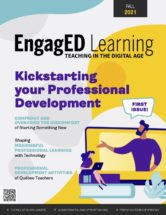This article is part of
Vol. 1, issue 1 (Fall 2021)
of EngagED Learning magazine.
By Tom Daccord, CEO and co-founder of EdTechTeacher
Twitter: @thomasdaccord
In a flash, COVID-19 forced a dramatic shift in teaching and learning. Schools pivoted to remote instruction and educators quickly immersed themselves in educational technology—willing or not. Schools scrambled to adjust to this new educational environment and many teachers struggled to forge effective teaching environments online.
However, many teachers seized the opportunity to learn more about educational technology and to rethink the student learning process. These teachers often turned their efforts to envisioning and constructing active learning environments in which students learned more independently. In these classrooms, students often tackled challenging tasks and created interactive content in response — educational videos, interactive reports, group podcasts — thus demonstrating learning in varied ways.
For the last thirteen years, EdTechTeacher has worked with schools and districts in the U.S., Canada and abroad to deliver professional development workshops and presentations to tens of thousands of educators. These experiences have shown us that to create and sustain pedagogical change in classrooms, professional learning with technology should focus on a vision of student learning more than the “nuts and bolts” of a particular platform or app. The key to instructional improvement is the mindset of our educators, so the primary focus of professional learning should be the educator’s vision of a technology in student learning, and not the technology itself.
We believe that a worthwhile mission of teaching with technology is to prepare students for the challenges of today’s (and tomorrow’s) interconnected, globalized, and tech-laden economy and society. We believe that educators should strive to prepare students effectively for an ever-changing labor market and society where technology presents opportunities and challenges – many we cannot anticipate. We feel that we should be preparing students for a world in which tasks and responsibilities are constantly changing and new ones emerging. In essence, we aim to help students learn how to learn. We believe that an effective way of doing so is to challenge students to solve unstructured problems and use digital tools to develop creative solutions.
Schools and educators that embrace such a vision are committed to nurturing creative learning environments where students are engaged in active inquiry, problem solving, and taking increased responsibility for their own learning. Teachers in these classrooms focus more on “how my students can learn using technology” and less on “how I can teach using technology.” And administrators in these schools work with teachers to articulate a vision for how technology will enhance learning and help educators imagine how leveraging technology can support those visions.
What are some of the ways we can shape effective professional learning sessions with technology?
1. Constructivist learning
Professional learning workshops and courses should attempt to simulate the types of learning environments we hope teachers will emulate in their classrooms. For example, professional learning can be characterized by experiential learning with a distinct focus on participant-directed learning. If we let teachers learn more through exploration and less through imitation (“click here, click there”), participants are prompted to actively discover the potential of a platform, app or a device.
Providing teachers with ideas and examples of how a particular technology might be leveraged for teaching and learning is important, but ultimately we must ask them (and, by extension, their students) to make sense of the tools themselves,to assume increased responsibility for their own learning.
2. Goal-oriented
It’s a good idea to structure professional development around challenges rather than simply repetition. This nurtures empowerment and not dependency. If participants can work independently of the trainers, they gain some measure of confidence that they can tackle future problems. So, trainers should avoid explaining every step in using a certain technology, but rather structure learning goals developmentally. For instance, after a brief introduction to a learning goal and a corresponding tool, why not give participants time and support to accomplish a set of tasks and start to envision ways that the tool might be leveraged to meet their teaching objectives? Thus, participants spend their time exploring and evaluating resources.
3. Collaborative
Goal-oriented learning can be hard for participants who are more accustomed to learning through direct instruction and imitation. Breaking participants into small groups is an attempt to make everyone feel supported. (A useful tip: tell everyone that they can help each other, but that they cannot touch someone else’s device.) Make teachers exchange ideas and experience a collaborative classroom and use of technology from a student perspective.
We also believe that preparing students to be successful global citizens means developing their ability to collaborate and communicate with others. (There is hardly a profession today that does not require effective collaboration and communication.) We also know that teachers change their instructional practices mostly as a result of peer-to-peer interaction, and less from top-down objectives. So, if we can nurture environments where teachers interact and reflect, then we can help them grow professionally.
4. Differentiated
Try to provide both beginner and advanced challenges, so that participants can work at their own pace. It’s also important to provide a choice of tools to accomplish a similar objective. Doing so enables the introduction of strategies for differentiated learning, offering diverse learners different ways of understanding and using tools. Participants are using select tools to demonstrate their learning multimodally, via audio, video, images and more.
5. Personalized
It’s important for instructors to circulate amongst working groups and provide just-in-time assistance and encouragement. Serving as facilitators, and less as experts, allows to find an appropriate balance between independent-exploration and instructor-direction.
Limiting whole-group instruction time gives the instructor freedom to move about the room and work with participants on a more individual level, providing guidance and support. This also makes learning less centered on the instructor “teaching” and more focused on the participants “learning.”
The COVID-19 age has demonstrated the need for creative problem-solvers, such as scientists developing vaccines at a record pace and business shifting to remote work. Almost all sectors of society underwent major upheaval and many citizens are continuing to adapt to major changes in their professional and personal lives. We believe that professional learning should inspire teachers to integrate technologies as creative platforms in response to important challenges and help manifest student learning and nurture essential skills for our digital age. Learning environments for teachers and students that empower them to assume more control over their learning and demonstrate understanding through various modalities help embolden us all to be proactive digital citizens and creative problem solvers.




